Monday 10th May 2021

It’s just over six months since the new station at Kintore reopened for business on 15th October 2020. I caught up with a visit today to check it out.

I was interested to see how the new station, located 12 miles north west of Aberdeen and costing £15 million, compared to other recent new station openings at Bow Street (Aberystwyth) (February 2021), Horden (June 2020), Worcestershire Parkway (February 2020), Robroyston (December 2019), Warrington West (December 2019) and Meridian Water (June 2019).

A £15 million price tag seems to be the going rate for a bog standard unmanned two platform station with lifts and footbridge these days. Both Warrington West and Robroyston cost a similar £14 million, as did Bow Street. However Warrington West comes with a sizeable ticket office and waiting room as well as a footbridge across the sunken tracks; Robroyston had no ticket office but does have lifts and a footbridge between the platforms (very similar to Kintore in fact), and as we saw at Bow Street, the cost of the basic one platform minnow of a station was inflated by road improvements alongside the station.
Worcestershire Parkway cost £22 million but has substantial infrastructure across its three platforms serving two different railway lines. Meridian Water was in a completely different league at £46 million but this included an extra track leading into a terminating bay platform as well as its two through platforms. Bargain new station of the pack so far has definitely been Horden costing just £10.5 million for the two platform basic facility, and those really long ramps to the overbridge between the platforms saving the cost of lifts.
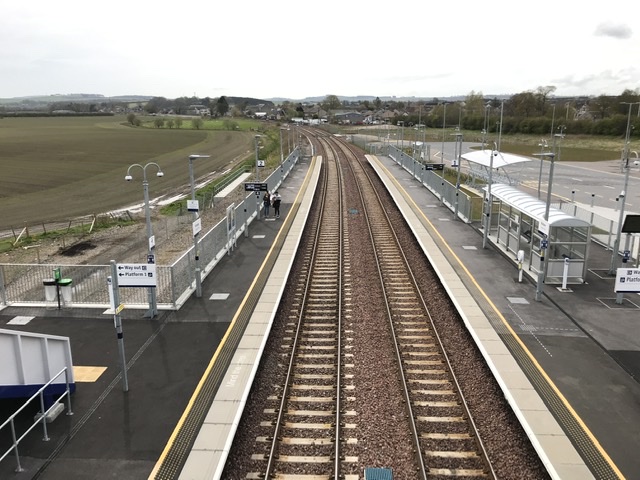
Back to Kintore where the £15 million has come from Transport Scotland, Aberdeenshire Council and Nestrans (an acronym for the North East of Scotland Transport Partnership – principally Aberdeen City Council working with Aberdeenshire Council). It’s a two platform affair on the recently expanded Aberdeen to Inverness line.
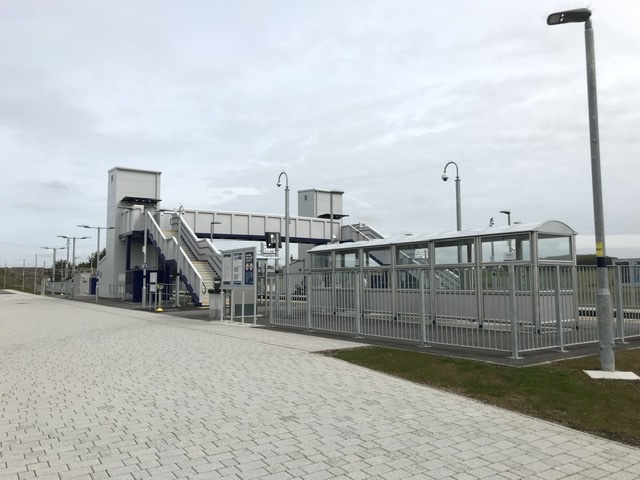
It’s always good to welcome a new station to the network and encouraging to see a couple of passengers arriving or departing on each of the three trains I saw calling this morning.
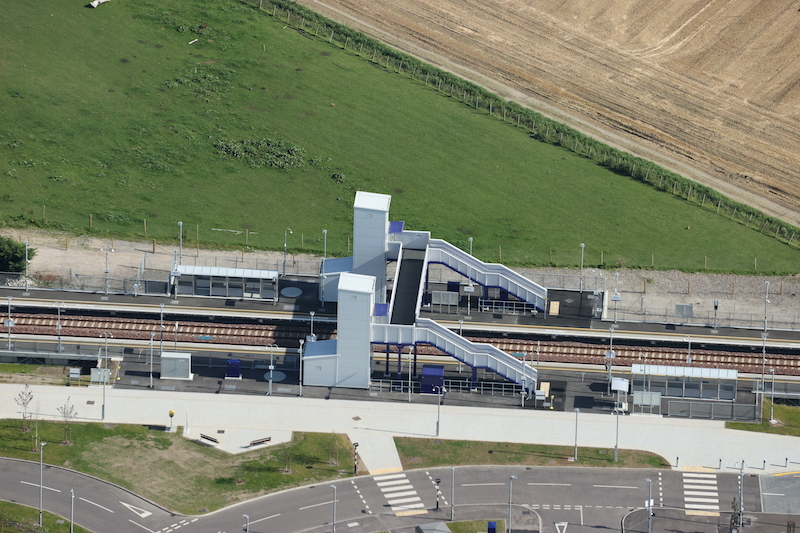
Kintore’s facilities include a footbridge with lifts and stairs; a ticket machine; smart card readers; a help point; a shelter on each platform with perch and bench seating; some open platform seats; two electronic departure signs per platform and one by the entrance; a 168-space car park (with 24 charging spaces), bike storage facilities and a bus stop marking and shelter.




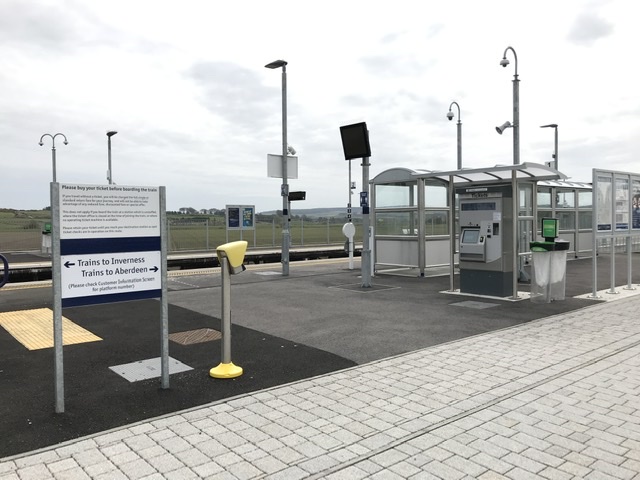


And that’s about it.
Oh and quite a few cabinets with gubbins inside, goodness knows what though! But there’s lots of them.

A nice touch is that signs and benches from the original station have been refurbished and installed at the new station.

That original station was located about a third of a mile south of today’s new station and closed in 1964.
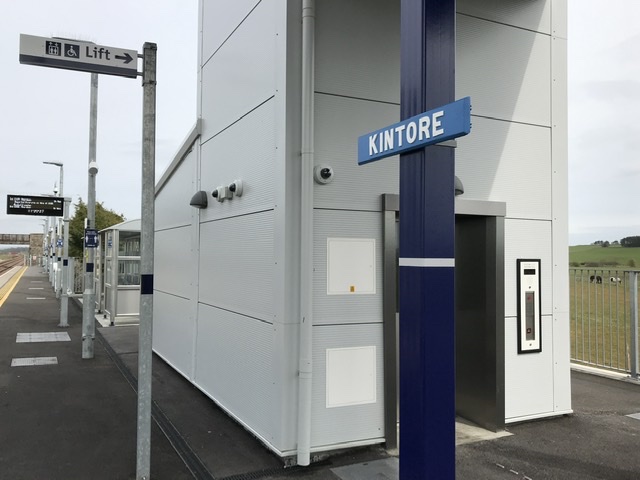
Kintore’s new station has been made possible by the completion of phase one of the Aberdeen to Inverness Improvement Project which has doubled the track between Aberdeen and Inverurie (the next station north of Kintore) thereby increasing the line’s capacity. Frequency of service has improved and there are now better paths for freight trains.
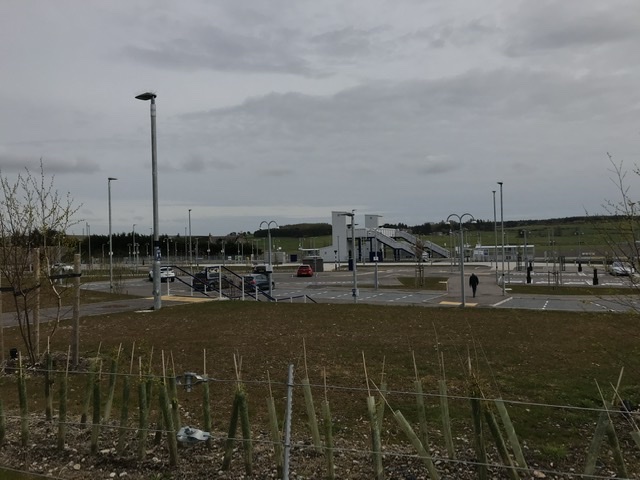
It will be served by “up to 28 ScotRail trains each day” according to Network Rail’s press release. I can’t give you more details because ScotRail aren’t displaying any timetables (even online) at the moment, and I don’t have the time to use a journey planner across the whole day to work out all the departures.
Update: Thanks to those who’ve commented below and linked to real time trains showing there are 46 trains per day – although that’s counting trains in both directions.
Searching out for positives to include in a press release about a bog standard two platform station with limited facilities, Network Rail added Kintore provides “an interchange between rail and road”.
An accolade which escapes only Altnabreac, Berney Arms, Corrour, Dovey Junction, Middlewood and Smallbrook Junction stations. All Britain’s other 2,457 stations can also boast an interchange “with road”.
The same hyped up press release celebrating Kintore’s opening claims the station is “connected to the local bus network”. This may refer to the reference on WSP’s drawing for the “Proposed Transport Interchange” (don’t you just love the use of the word “Interchange”?) that it includes a “stand for 3 buses”.

However, reading the notes below advise “it is intended the bus stand will only be utilised in the instance that the trains are not running and a bus service needs to be provided by Network Rail. The existing bus stops on Northern Road will be retained”.
And sure enough they are.
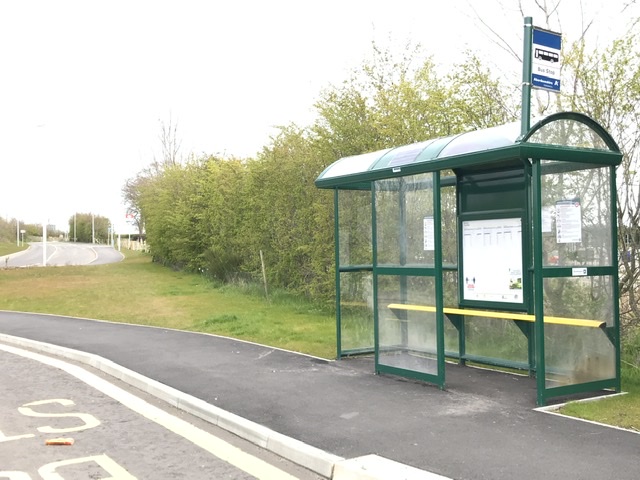
The ‘Welcome’ poster isn’t quite accurate when it refers to bus stop 2 as the “nearest bus stop” and shown on the little map, as this doesn’t exist.


Around 4,800 people live in Kintore. It’s served by Stagecoach’s hourly route 37 between Aberdeen and Inverurie plus six journeys a day on route 220 to Alford.
The journey time on the bus is around 50 minutes from Kintore to Aberdeen which compares to the train’s much more impressive 19 minutes.

However, the new station is located to the extreme north of Kintore making for a walk of around three quarters of a mile if you live in the centre of the town, and even more from the southern tip, if you don’t drive.
In fact there are no houses immediately surrounding the station which is just to the north of the town’s welcome sign on the B987, Northern Road, making it a bit of a station on the edge.

And that might just impact its competitive edge on the bus.

Roger French


Yet another station for cars rather than people.I use to favour opening new stations but I’m not so sure now.
LikeLike
46 trains per day according to Real Time Trains, between 0635 & 2054.
LikeLike
This may help all trains through Kintore
https://www.realtimetrains.co.uk/search/detailed/KTR/2021-05-10/0000-2359?stp=WVS&show=all&order=wtt
LikeLiked by 1 person
As much as some commentators would prefer it wasn’t the case, stations such as Kintore are effectively Park and Ride stations: the target demographic is people who would normally drive to Aberdeen and who now have a nice, big, free car park with regular trains into the city allowing them to avoid the city traffic.
Bus stops are there as a mere sop to multi-modal public transport; the assumption will always be that people will drive to the station. And if that gets cars off the road for most of the journey, then it’s a Good Thing!
LikeLiked by 1 person
A bit like Ivybridge, which was built right on the edge of town – and on the “wrong” side for the major traffic flow, towards Plymouth, don’t underestimate the psychological effect of starting your journey going away from your destination, it will put people off using the train even if it is quicker.
Although at least with 25 trains a day to Aberdeen, compared with the 11 from Ivybridge to Plymouth, and a quicker overall journey than the bus, it does offer a decent service, with trains generally every 30–60 minutes, although the regular interval service still eludes them.
It’s hard to see where the market it is aimed at will be coming from to use it as a P&R – a shame that a more central location wasn’t chosen, when it could easily have been built right in the town centre behind the post office where it would be within walking distance for a lot more residents, there’s easily enough space there for the station although a large car park would be harder to fit in.
LikeLiked by 1 person
I agree that a location closer to the Post Office might be better for the town – but there may not then have been room for the desired parking, or it might have contributed to increased traffic levels in the town’s shopping area. Also the River Don loops round nearby – is there a possible flooding issue here?
Regarding parking/Park & Ride, it is interesting to compare this and other station provided with generous parking, and the proposed new stations in South Wales that are intended very much to serve adjacent communities and which are planned to have no parking at all.
LikeLike
Functional, utilitarian, etc. It’s hard to see any of these stations facilities generating the kind of interest that Edwardian station canopies or Art-Deco Tube stations do.
LikeLiked by 2 people
Julian: It’s true the the station’s location appears close to the River Don (both horizontally and vertically). But the western half of the Aberdeen – Inverness line is far more susceptible to flooding than the eastern half (in particular, between Keith and Elgin).
Locations closer to the centre of the town are also closer to the river and do not appear (from looking at maps) to have much space for a car park. A town-centre location (even in a small town) may deter use as a park-and-ride station and result in increased road traffic in the town centre.
The park-and-ride catchment area includes Kemnay, a smaller town to the west from which there is significant traffic to Aberdeen for work, shopping and education. Road traffic from Kemnay to Aberdeen joins the A96 at Kintore (by the station). Inverurie is not suitable as a park-and-ride from Kemnay to Aberdeen because of the detour and congestion in Inverurie.
LikeLike